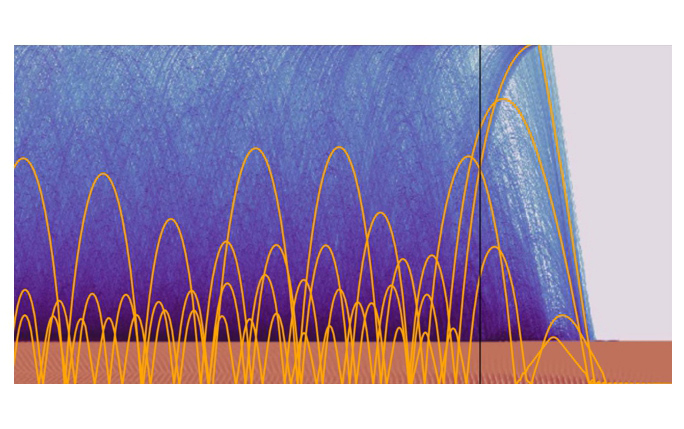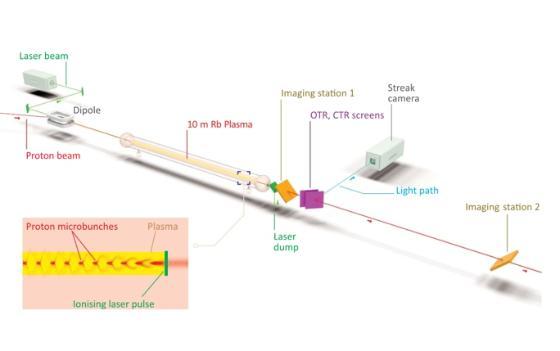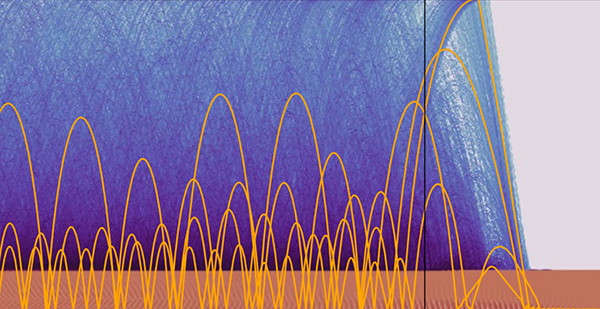Comparison between simulation and experiment in AWAKE experiment

Within LIV.DAT, Aravinda Perera’s project involves the development of enhanced models of beam-plasma interaction, including for the Advanced Wakefield Experiment (AWAKE), with a view to enabling optimisation and real-time diagnostics of beam properties in plasma wakefield acceleration (PWFA).
A new paper reporting on an important validation of a physical mechanism in proton-beam-driven PWFA has recently been published in Plasma Physical and Controlled Fusion by the AWAKE collaboration, of which Liverpool researchers Aravinda Perera, Dr Oznur Apsimon, Dr Joseph Wolfenden, Dr Ralph Fiorito and Prof Carsten Welsch are all co-authors.

Experimental schematic of AWAKE as used for Run 1 SSM measurements
Plasma Wakefield Acceleration (PWFA) is a novel technique that is poised to make a step-change in particle accelerator technology. Conventional accelerators, such as the 10m-long ones at the Clatterbridge Cancer Centre, are used for generating X-rays for medical imaging and for cancer therapy, while larger ones, like the 27 km-long Large Hadron Collider (LHC) at CERN, have been instrumental in major leaps in physics over the last century.
In proton-driven PWFA at AWAKE, a 12 cm-long beam of protons is diverted into a narrow channel of plasma where it excites an electrostatic wave (a plasma wakefield) which can in turn be used to accelerate an externally injected electron beam to very high energy. Because of its length, the proton beam must first be broken up into shorter ‘micro-bunches’ by the wave in a process called seeded self-modulation (SSM), which in turn enhances the plasma wakefield.

In a simulation, energetic electrons [blue] that lose coherence with the wakefield in the plasma channel [brown] are ejected out up to several times the plasma channel radius before returning into the wakefield [yellow tracks] - Image adapted from: A. A. Gorn, et al, 2020, Plasma Phys. Control. Fusion, 62, 125023
In August 2020, a paper published in Physical Review Accelerators and Beams by the AWAKE Collaboration found that patterns in the plasma-based seeded self-modulation (SSM) of the proton beam as well as the spectrum of energies reached by electrons in an externally injected beam, were in good agreement with first-principles simulations under the same experimental parameters. Such agreement both confirms the viability of using simulations to accurately model these novel acceleration schemes, which themselves are highly useful in understanding the detailed physics and electromagnetic fields involved.
The new paper presents a further simulation campaign, compared with experimental results, showing agreement of the SSM development over a range of values of the number of protons in the beam as well as of the density gradient in the plasma channel (used to stabilize aspects of the SSM). It has been found in simulations that electrons that decohere with the bulk plasma wave can be ejected out of the plasma channel, charging it positively, and then re-enter the wave later, perturbing the wakefield and the ongoing SSM process. This paper importantly shows that the agreement between experiment and simulation requires that such meandering electrons, often neglected in simulations, are taken into account, verifying their important role in AWAKE-like schemes.
Further information
A. A. Gorn, …, A. Perera, et al, (AWAKE Collaboration), “Proton beam defocusing in AWAKE: comparison of simulations and measurements”, Plasma Phys. Control. Fusion, Volume 62, Number 12, 125023 (2020).